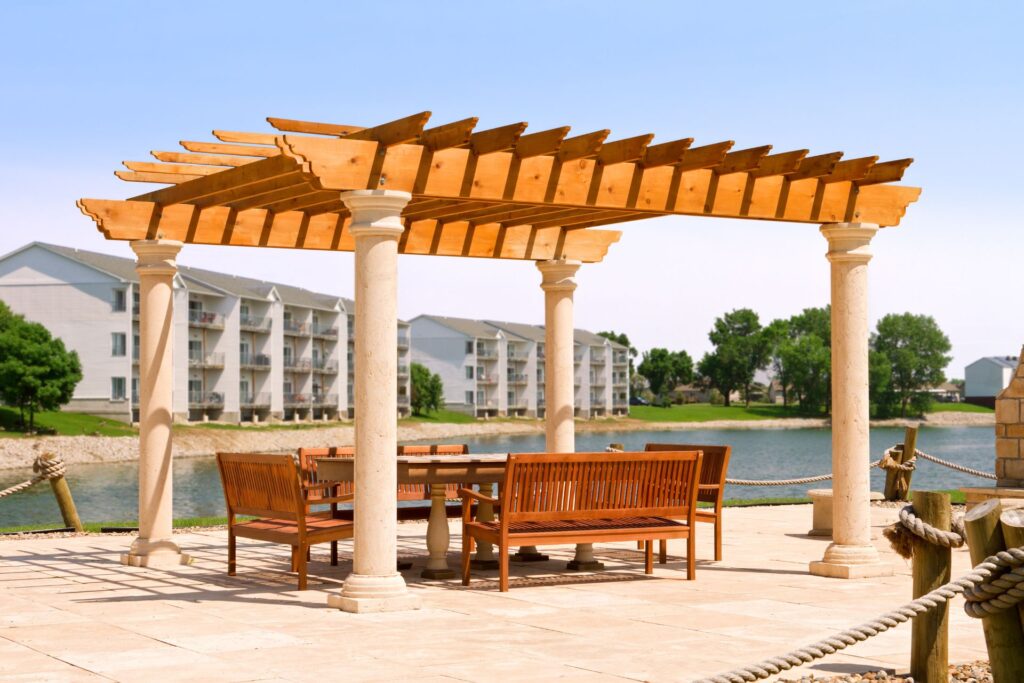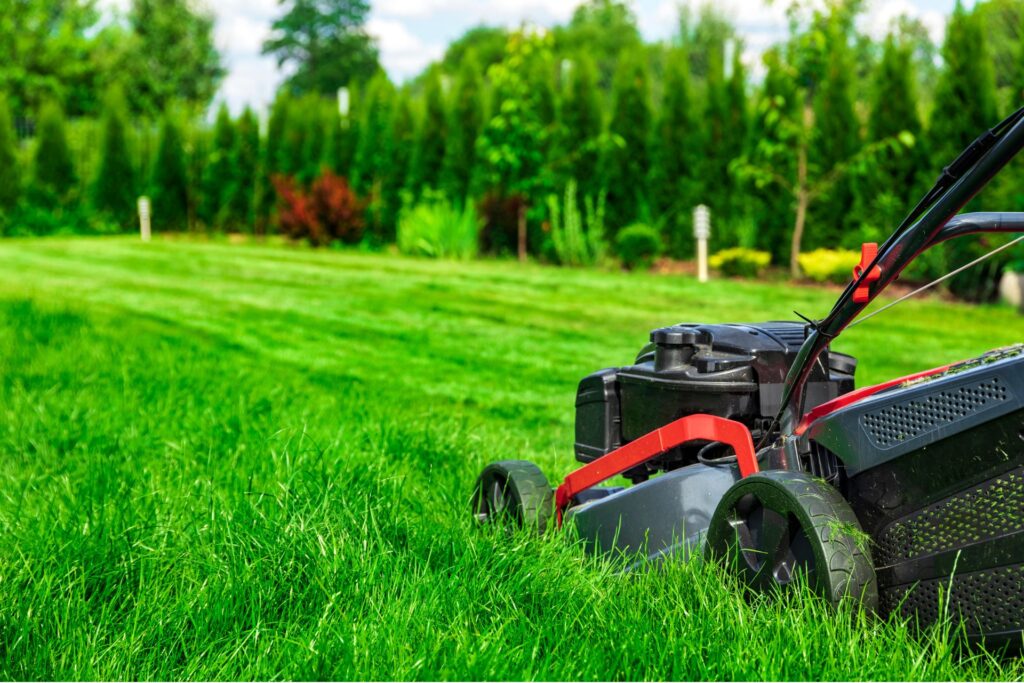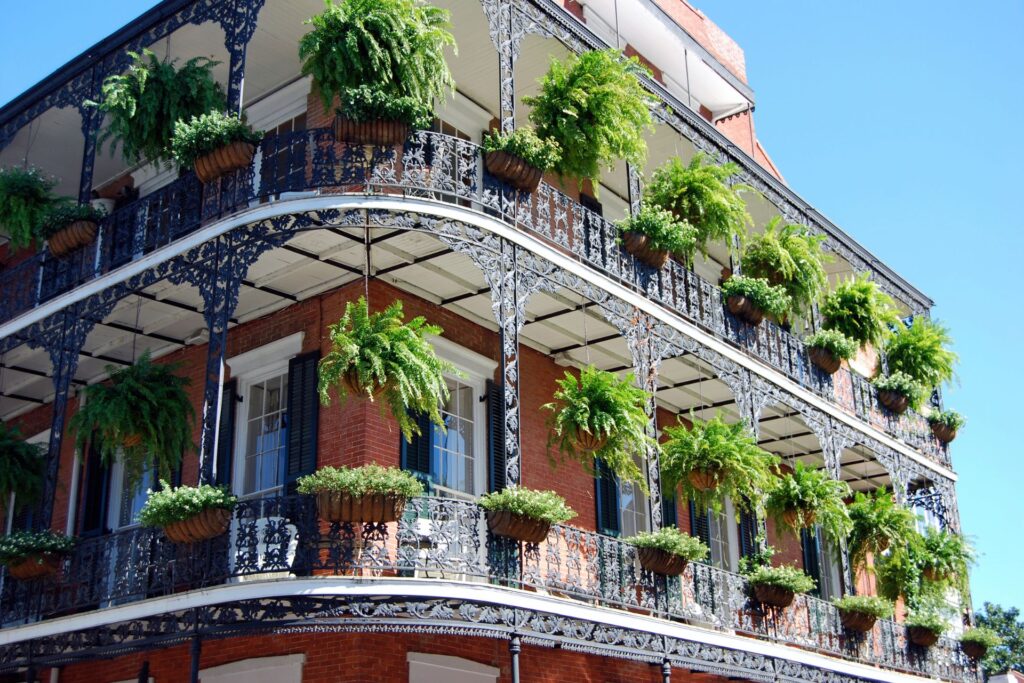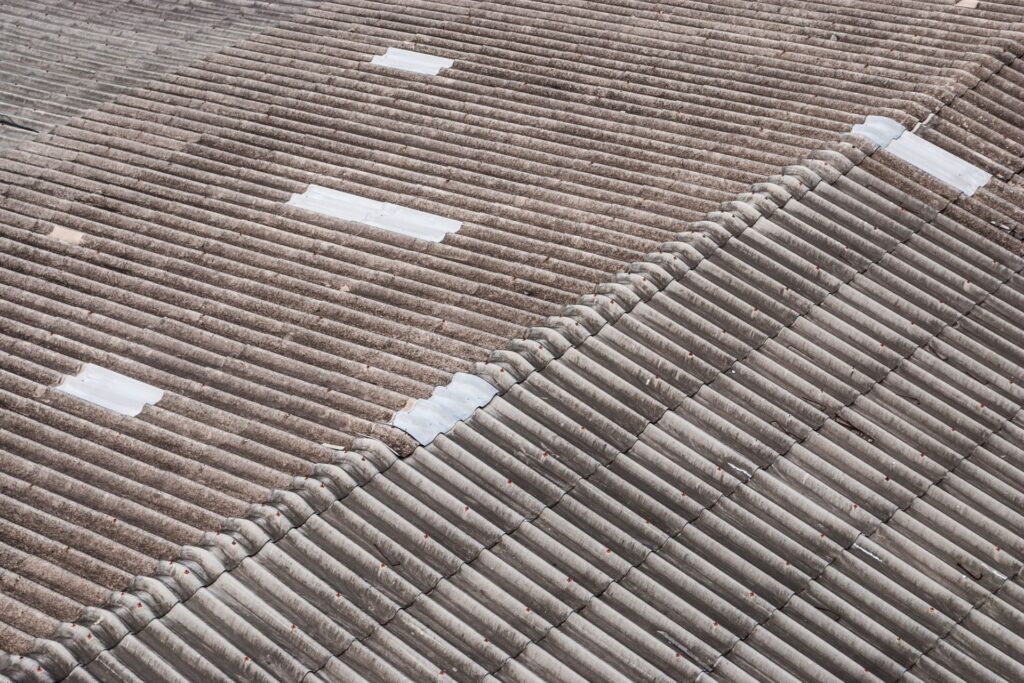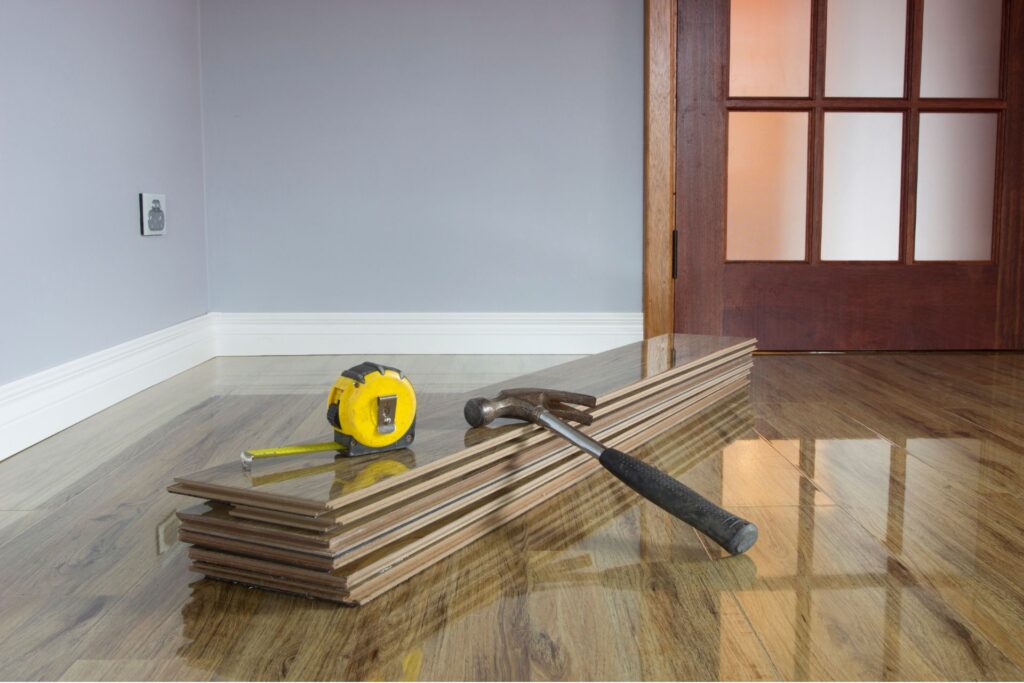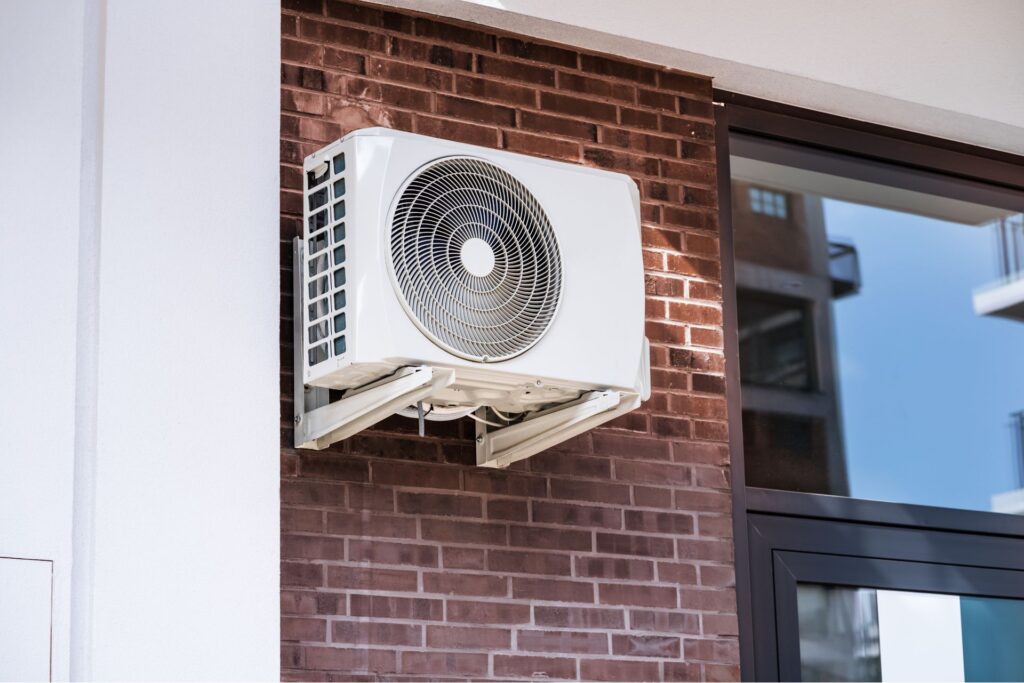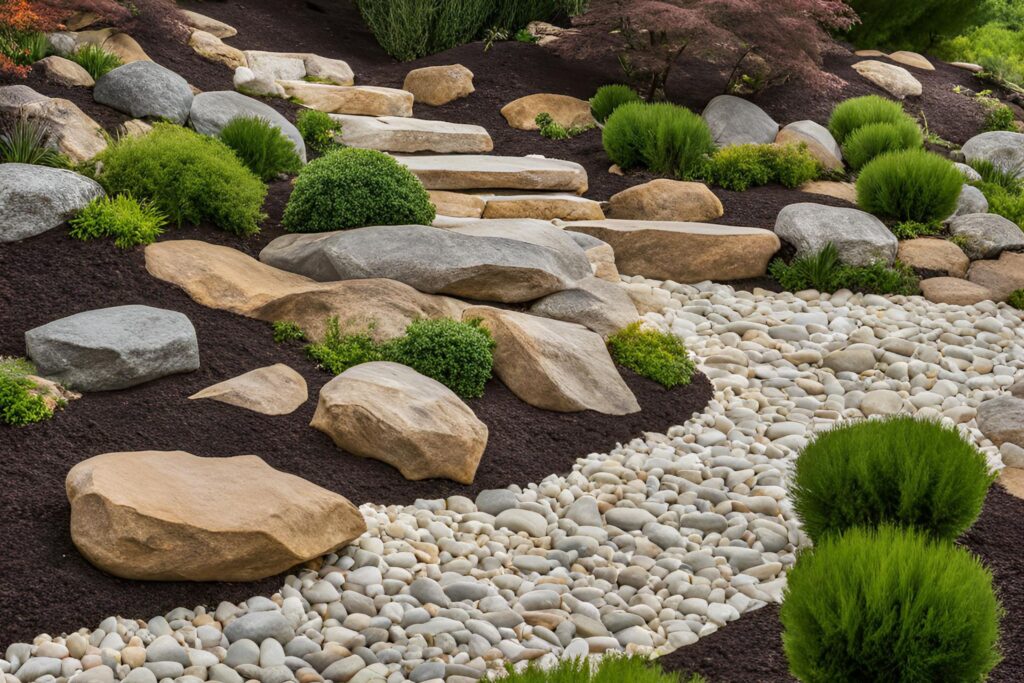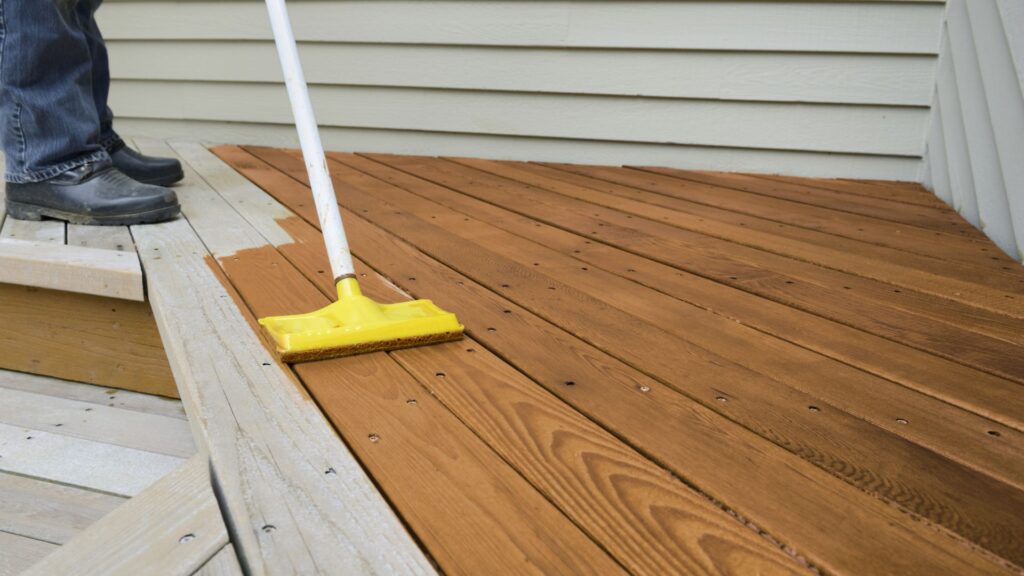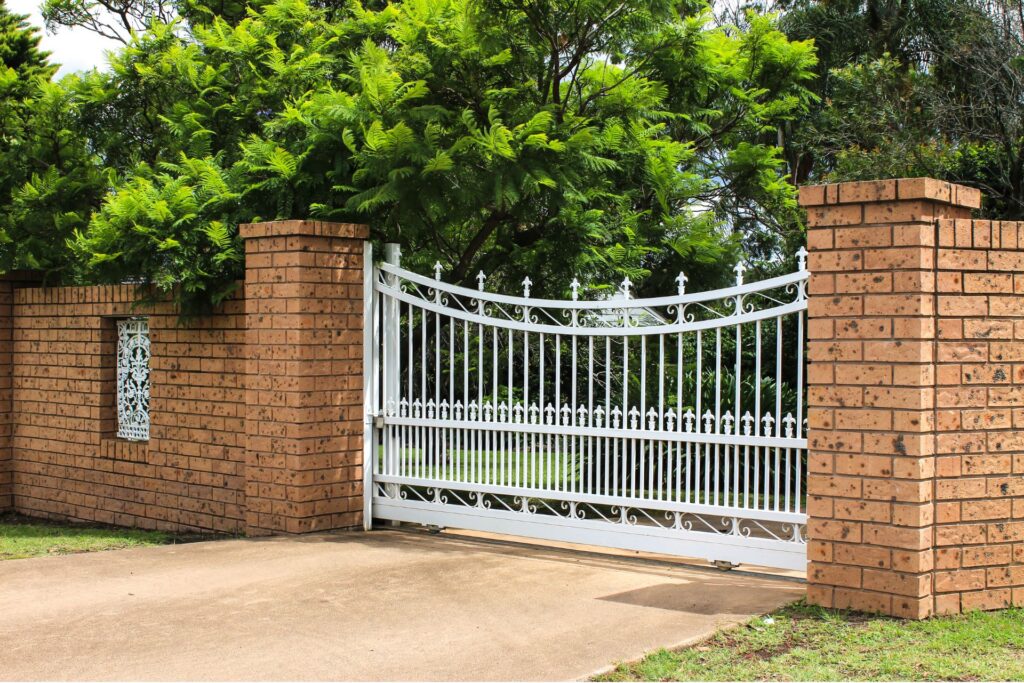Welcome to our comprehensive guide on selecting the best timber for your outdoor pergola, an essential feature that can transform your garden or backyard into a picturesque retreat. Pergolas not only enhance the aesthetic appeal of outdoor spaces but also provide a shaded sanctuary to enjoy nature’s beauty. The choice of timber plays a pivotal role in a pergola’s durability, maintenance, and overall harmony with the outdoor environment. With many options available, navigating through the choices to find the perfect wood that suits your climate, design preferences, and budget can be daunting. This guide is meticulously crafted to navigate you through the essentials of picking the right timber, ensuring your outdoor pergola stands the test of time, weather, and trends, and making your decision-making process as informed and straightforward as possible.
Choosing the right timber for your outdoor pergola is crucial for durability, aesthetics, and ease of maintenance. The best options include cedar, known for its natural resistance to rot and insects, and redwood, prized for its beauty and longevity. For a more budget-friendly choice, treated pine can be a viable option, offering durability at a lower cost. Hardwoods like teak offer unparalleled durability and low maintenance but come at a higher price. Consider factors such as climate compatibility, aesthetic appeal, and sustainability when selecting your timber. With their natural durability and aesthetic qualities, Cedar and redwood are among the top choices for creating a stunning, long-lasting outdoor pergola.
- Understanding Timber’s Role In Pergola Construction
- Types Of Timber Suitable For Outdoor Pergolas
- Factors To Consider When Choosing Timber
- Pros And Cons Of Popular Timber Choices For Pergolas
- Maintenance Tips For Timber Pergolas
- Innovative Design Ideas For Timber Pergolas
- Case Studies: Successful Outdoor Timber Pergola Projects
- FAQs: About The Best Timber For Outdoor Pergola
- Conclusion
- Find A Professional Pergola Builder Near You
Understanding Timber’s Role In Pergola Construction
Timber plays a pivotal role in the construction of pergolas, blending both structural robustness and aesthetic appeal. This guide delves into the nuances of timber’s importance in pergola design and highlights key considerations for selecting the perfect wood for your project.
Timber: The Backbone of Pergola Design
Timber is more than just a building material for pergolas; it’s the backbone that shapes both their form and function. Structurally, wood provides the necessary strength and durability to support the pergola’s weight and withstand environmental stresses. Aesthetically, timber brings a natural, warm, and inviting look to the design and is easily adaptable to various styles and preferences. From rustic to contemporary, the choice of wood can dramatically influence the pergola’s visual impact, making it a central feature in outdoor living spaces.
The Aesthetic Appeal of Timber
The natural beauty of timber, with its varied grains, colors, and textures, offers unmatched aesthetic versatility in pergola construction. Whether it’s the rich hues of redwood or the soft tones of cedar, wood can be tailored through stains, paints, and finishes to match any design theme. This adaptability ensures that the pergola not only serves its functional purpose but also enhances the overall ambiance of the garden or patio.
Choosing the Right Timber: Factors to Consider
Selecting the right timber for your pergola involves more than just picking the most attractive wood. Several critical factors influence this decision, ensuring that the structure remains beautiful and functional over time:
Climate: The local climate plays a significant role in wood selection. Woods like teak and cedar are renowned for their resistance to weathering, making them ideal for humid or rainy climates. Conversely, woods that resist cracking and warping, such as redwood, are preferable in dry, hot areas.
Pests: The threat of pests, including termites and wood-boring insects, cannot be overlooked. Choosing naturally resistant woods or those treated for pest resistance can prolong the life of your pergola.
Available Treatments: Wood treatments can enhance durability, and resistance to rot, pests, and moisture. When selecting timber, consider whether it has been pre-treated or if you’ll need to apply protective coatings. These treatments not only extend the lifespan of your pergola but also maintain its appearance over time.
Sustainability: With growing environmental concerns, the sustainability of the timber source is another important consideration. Opt for woods certified by organizations like the Forest Stewardship Council (FSC), which ensures that the timber is harvested responsibly.
Timber is at the heart of pergola construction, offering structural integrity and aesthetic flexibility. Its selection is a delicate balance between beauty, functionality, and environmental considerations. By understanding the factors affecting wood choices, such as climate, pests, and available treatments, you can ensure your pergola not only stands the test of time but also becomes a cherished feature of your outdoor living space.

Types Of Timber Suitable For Outdoor Pergolas
When considering building an outdoor pergola, choosing the right type of timber is crucial to ensure durability, aesthetic appeal, and resistance to the elements. Pergolas add a beautiful touch to any outdoor space, providing shade and a structure for climbing plants, making the selection of the right wood a pivotal decision. Here, we explore the types of timber suitable for outdoor pergolas, focusing on softwoods, hardwoods, and modified woods, each offering unique benefits for your project.
Softwoods for Pergolas
Pine is a popular choice for those on a budget without compromising quality. Its affordability makes it an attractive option for many homeowners. However, pine is a softwood, which means it’s less resistant to the elements compared to hardwoods. To counter this, pine can be treated with preservatives that enhance its durability, making it more resistant to rot, insects, and moisture. This treatment extends the life of pine structures outdoors, ensuring your pergola remains a stunning feature of your garden for years.
Cedar stands out for its natural beauty and a multitude of benefits ideal for outdoor use. This softwood is inherently resistant to rot, decay, and pest infestations, thanks to its natural oils. Cedar’s appealing color palette, which ranges from light amber to deep honey brown, weathers gracefully to a silvery grey when left untreated, enhancing the aesthetic appeal of your pergola. Its durability and minimal maintenance requirements make cedar a premium choice for those looking to invest in quality and longevity.
Hardwoods for Pergolas
Teak is renowned for its exceptional durability and resistance to various weather conditions. This hardwood is highly prized for outdoor furniture and structures due to its natural oils that repel water, preventing rot and fungal growth. Teak’s dense grain and natural resistance to pests make it a low-maintenance option, requiring minimal care to maintain its rich, golden-brown color and integrity over time. While teak is on the higher end of the price spectrum, its longevity and minimal upkeep make it a worthwhile investment for an exquisite outdoor pergola.
Redwood is another excellent choice for outdoor pergolas, celebrated for its natural beauty and resilience. This hardwood boasts a rich, vibrant color that adds warmth and elegance to any outdoor space. Redwood is naturally resistant to shrinking, warping, and cracking, ensuring your pergola retains its shape and beauty through varying weather conditions. Its longevity and resistance to decay and pests make redwood a superior choice for those looking to create a timeless outdoor structure.
Modified Woods for Pergolas
The advancement in wood modification technology has introduced Thermally Modified Wood and Acetylated Wood as viable options for outdoor pergolas. These processes enhance the wood’s durability and resistance to environmental factors. Thermally modified wood is treated with heat in the absence of oxygen, altering its chemical structure to increase its resistance to rot and decay. Acetylated wood undergoes a process that replaces the hydroxyl groups in wood with acetyl groups, making it highly resistant to moisture, swelling, and fungal decay. Both options offer an environmentally friendly alternative to traditional preservative treatments, providing enhanced durability and a longer lifespan for outdoor structures.
Selecting the right timber for your outdoor pergola depends on various factors, including budget, maintenance preference, and desired aesthetic. Softwoods like pine and cedar offer affordability and natural beauty, while hardwoods such as teak and redwood provide unmatched durability and resistance to weather conditions. For those seeking advanced durability and environmental sustainability, modified woods like thermally modified and acetylated wood present innovative solutions. Whatever your choice, ensuring you select a timber suited to withstand the outdoor environment will guarantee your pergola remains a central feature of your garden for many years.
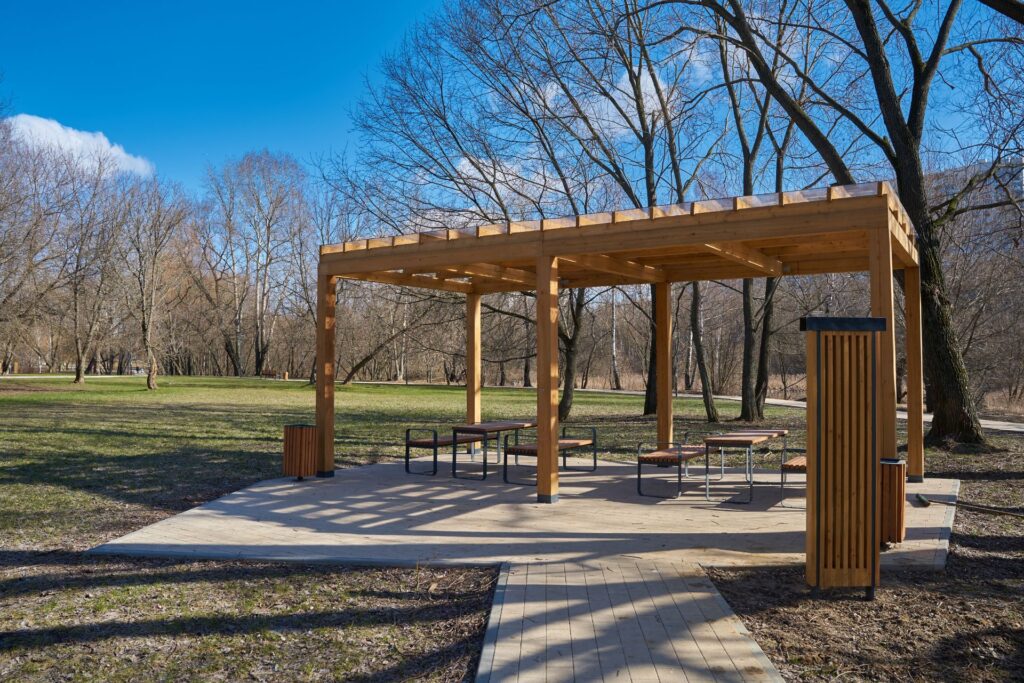
Factors To Consider When Choosing Timber
When embarking on a project that involves choosing timber, it’s vital to consider various factors that influence not only the longevity and appearance of the wood but also its impact on the environment and your budget. These considerations ensure that the chosen timber not only meets the specific requirements of your project but also aligns with sustainability goals and cost considerations. Let’s delve into these key factors:
Climate Compatibility
One of the foremost considerations when selecting timber is its compatibility with your local climate. Different wood types react differently to environmental conditions such as moisture, temperature fluctuations, and exposure to sunlight. For instance, hardwoods like teak and mahogany are renowned for their resistance to weathering and are an excellent choice for outdoor furniture or decking in areas with harsh weather conditions. On the other hand, softwoods like pine may require more maintenance when used outdoors. Understanding how weather conditions affect wood durability is crucial in choosing a timber that will stand the test of time and maintain its integrity and appearance.
Aesthetic Appeal
The beauty of wood lies in its natural color, grain, and the unique way it ages over time, which collectively contribute to the aesthetic appeal of your project. The choice of timber can dramatically influence the look and feel of your project. For example, the rich, warm tones of walnut or cherry wood can add elegance and sophistication to interior furniture, while the light, airy hues of birch or maple can create a more contemporary look. Additionally, the grain pattern of the wood – whether straight, interlocked, or wavy – can add texture and character. When selecting timber, consider how its natural color and grain will complement your project’s design and how it will age over time, potentially enhancing its beauty.
Maintenance Requirements
Maintenance is a critical factor that can affect the lifespan and appearance of timber. Some types of wood require regular treatments with oils or sealants to maintain their color and protect against weathering, while others are more low maintenance. For example, cedar is naturally resistant to rot and insect damage, making it a popular choice for outdoor applications with minimal maintenance needs. In contrast, softer woods may require more frequent treatments to prevent decay. Comparing the maintenance needs of different types of timber can help you choose a material that suits your capacity for upkeep.
Sustainability
The environmental impact of timber sourcing is an increasingly important consideration. Opting for timber from sustainable sources ensures that your project contributes to the conservation of forests and the responsible management of natural resources. Look for certifications like FSC (Forest Stewardship Council) or PEFC (Programme for the Endorsement of Forest Certification) to verify that the timber has been sourced from well-managed forests with sustainable practices. Choosing sustainable timber not only supports environmental preservation but also promotes ethical business practices in the timber industry.
Cost
Finally, the cost is a significant factor in choosing timber. The price of wood varies widely depending on its type, quality, and availability. Exotic hardwoods are generally more expensive due to their superior durability and aesthetic qualities, as well as their scarcity. Locally sourced timber can be more affordable and reduce transportation emissions, contributing to the project’s overall sustainability. Understanding the cost implications of different timber choices allows you to balance your project’s aesthetic and functional requirements with your budget.
In summary, selecting the right timber involves a holistic consideration of climate compatibility, aesthetic appeal, maintenance requirements, sustainability, and cost. By taking these factors into account, you can choose a timber that not only enhances the beauty and functionality of your project but also aligns with environmental sustainability goals and budget constraints.

Pros And Cons Of Popular Timber Choices For Pergolas
Creating the perfect outdoor space often involves choosing the right materials, especially when it comes to building a pergola. Timber, with its natural beauty and warmth, remains a popular choice for pergola construction. However, not all wood is created equal, and the variety of timber options available comes with its own set of pros and cons. In this guide, we’ll delve into a comparative analysis of popular timber choices for pergolas, evaluating their longevity, maintenance requirements, aesthetics, and cost to help you make an informed decision.
Cedar
Pros
Aesthetics: Cedar is renowned for its rich color and attractive grain patterns, adding a rustic charm to any outdoor space.
Longevity: Naturally resistant to rot, decay, and insect infestations, cedar pergolas can last 15-20 years if properly maintained.
Maintenance: Requires minimal maintenance. A coat of stain or water repellent every few years can keep it looking fresh.
Cons
Cost: Cedar’s superior qualities come at a higher price point compared to some other woods, making it a significant investment.
Weathering: Without regular maintenance, cedar can fade to a grayish color, which might not appeal to everyone.
Pressure-Treated Wood
Pros
Cost: It’s the most affordable option for those on a budget, making it accessible for a wider range of projects.
Longevity: Chemical treatments make this wood resistant to rot, decay, and termites, extending its life span up to 20 years or more.
Cons
Aesthetics: The chemical treatment process can leave the wood with a less natural, somewhat greenish tint.
Maintenance: Requires regular maintenance, including staining or painting to protect against weather and UV damage.
Chemicals: Some people have concerns about the chemicals used in the pressure-treating process, especially in areas frequented by children or pets.
Redwood
Pros
Aesthetics: Offers a stunning, natural look with its deep red hues and fine grain, enhancing the beauty of any garden or outdoor area.
Longevity and Maintenance: Redwood is naturally resistant to rot and pests, making it durable with minimal maintenance. However, to preserve its color, a sealant is recommended every few years.
Cons
Cost: Redwood is one of the more expensive options due to its aesthetic appeal and durability.
Availability: Depending on your location, redwood can be harder to find, potentially adding to the cost.
Teak
Pros
Durability: Known for its exceptional durability and resistance to weather, rot, and pests, teak can last up to 50 years.
Aesthetics: Teak has a beautiful, golden-brown color and a tight grain that makes it a luxurious choice for high-end pergolas.
Cons
Cost: Teak is the most expensive option due to its superior qualities and demand in the market.
Maintenance: While low maintenance, to keep its golden color, teak requires regular oiling; otherwise, it will naturally turn to a silver-gray patina.
Composite Timber
Pros
Maintenance: Composite timber, made from a blend of wood fibers and plastic, is virtually maintenance-free, requiring only occasional cleaning.
Longevity: Resistant to rot, decay, pests, and weathering, composites can last as long as 25-30 years.
Cons
Cost: Generally more expensive than natural wood options, but the lack of maintenance costs can offset the initial investment over time.
Aesthetics: While technology has greatly improved the look of composite wood, some may feel it lacks the natural charm of real timber.
When choosing the right timber for your pergola, it’s essential to balance aesthetics with functionality and cost. Whether you prefer the natural beauty and warmth of cedar or redwood, the affordability and durability of pressure-treated wood, the luxurious appeal of teak, or the low-maintenance convenience of composite timber, each material offers unique benefits to suit various preferences and budgets. Remember, the best choice is one that aligns with your specific needs, climate conditions, and personal taste, ensuring that your outdoor space remains a source of joy and relaxation for years to come.

Maintenance Tips For Timber Pergolas
Creating an inviting outdoor space often involves integrating elements that blend with nature, and timber pergolas do just that, offering both aesthetic appeal and functionality. However, to ensure these beautiful structures continue to enhance your garden or patio for years to come, proper maintenance is essential. Below are some practical tips on how to keep your timber pergola looking its best, ensuring it remains a focal point of your outdoor living space.
Regular Cleaning
One of the most fundamental steps in maintaining a timber pergola is to keep it clean. Over time, dirt, grime, and algae can build up, especially in damp conditions, detracting from the wood’s natural beauty and potentially leading to decay. To clean your pergola, you’ll need a soft brush or cloth and a mild detergent. Gently scrub the timber to remove any surface dirt, being careful not to damage the wood. For tougher stains or areas with algae growth, a specialized wood cleaner may be necessary. After cleaning, rinse the pergola thoroughly with water to remove any soap residue.
Staining and Sealing
To protect the timber from the elements and to enhance its appearance, consider staining and sealing it every two to three years, or as needed. Staining helps to preserve the wood’s natural color, preventing it from fading under the sun’s harsh rays. Sealing, on the other hand, adds a protective layer against moisture, reducing the risk of rot and insect damage.
Before applying any stain or sealant, ensure the wood is clean and dry. Apply the stain evenly with a brush or roller, following the manufacturer’s instructions. Once the stain has dried, apply a sealant to provide an additional layer of protection. It’s important to choose products specifically designed for outdoor use and suitable for the type of timber your pergola is made from.
Regular Inspections
Regularly inspect your timber pergola for signs of wear and tear or structural damage. Look for cracks, splits, or rot, especially in areas where the wood is in direct contact with the ground. These issues, if left unaddressed, can compromise the pergola’s integrity and safety.
In addition to visual inspections, pay attention to how the pergola stands up to weather conditions. After heavy rain or wind, check for any loosened connections or weakened sections. Tighten any loose bolts and replace damaged parts as necessary to maintain the structure’s stability.
Immediate Repairs
If during your inspections you find any damage, it’s crucial to address these issues promptly. Small problems, such as minor cracks or loose fittings, can quickly escalate into more significant concerns if ignored. For minor damage, you might be able to perform the repairs yourself using wood filler or replacement parts. However, for more severe damage or structural concerns, it’s wise to consult a professional.
By following these maintenance tips, you can ensure your timber pergola remains a durable, beautiful, and functional addition to your outdoor space. Regular care not only extends the life of your pergola but also enhances the enjoyment and value of your home.

Innovative Design Ideas For Timber Pergolas
Creating an enchanting outdoor space often begins with the allure of a beautifully designed pergola. Timber pergolas, with their natural warmth and timeless charm, can transform any backyard into a serene retreat or a lively entertainment area. This guide is packed with innovative design ideas and decoration suggestions aimed at inspiring homeowners to customize their outdoor pergolas, making them a true extension of their living space. Whether you’re looking to integrate your pergola with your garden, enhance your outdoor living areas, or illuminate your nights with enchanting lighting, we’ve got you covered. Let’s dive into the world of timber pergola design and decoration, where functionality meets creativity.
Embracing Nature with Your Timber Pergola
One of the most striking ways to enhance a timber pergola is by harmonizing it with the natural elements of your outdoor space. Consider integrating climbing plants or vines that can weave their way through the pergola’s structure, adding both shade and a lush, green aesthetic. Fragrant climbers like jasmine or honeysuckle not only add beauty but also envelop your space in delightful scents. For a more structured approach, incorporating planters with seasonal blooms or evergreens can add color and life to your pergola throughout the year.
Customization Through Lighting
Lighting plays a pivotal role in setting the mood and extending the usability of your pergola after sunset. String lights offer a simple yet magical solution, creating a cozy, starlit canopy. For a more dramatic effect, installing integrated LED strips along the beams can highlight the pergola’s architectural features and provide ambient lighting. Solar-powered lanterns placed around the perimeter or hanging from the pergola can also add a charming glow, ensuring your outdoor space is welcoming, day or night.
Merging Indoor Comfort with Outdoor Living
To truly make your pergola an extension of your indoor living space, consider outfitting it with comfortable, weather-resistant furniture. A well-chosen outdoor sofa or a set of armchairs can turn your pergola into the perfect spot for relaxation or social gatherings. Adding a weatherproof rug and some throw pillows can further enhance the comfort and aesthetic appeal. For those who love to dine al fresco, incorporating an outdoor dining area under the pergola can provide an idyllic setting for meals under the sky.
Creating Zones with Your Timber Pergola
For larger spaces, your pergola can serve as a stylish divider, creating distinct zones within your garden or backyard. One section could serve as a tranquil reading nook, while another could host your outdoor kitchen and dining area. This not only maximizes the functionality of your outdoor space but also adds an element of surprise and discovery as you move from one zone to another.
Incorporating Technology for a Modern Twist
In today’s digital age, integrating technology into your pergola design can add convenience and a touch of modernity. Weatherproof speakers for ambient music, Wi-Fi extenders to ensure connectivity, and smart lighting systems that can be controlled via smartphone are just a few options to consider. This blend of natural timber aesthetics with modern technology creates a space that’s both timeless and contemporary.
Crafting the perfect timber pergola for your outdoor space is about blending creativity with functionality. By considering the natural environment, incorporating lighting and comfortable furnishings, and perhaps even integrating modern technology, you can create a space that not only looks beautiful but also serves your needs and lifestyle. Whether you’re looking for a quiet place to relax, a vibrant area to entertain, or a cozy retreat to enjoy the outdoors, these innovative design ideas can help turn your vision into reality. Remember, the key to a captivating pergola design lies in personalization—making the space uniquely yours.

Case Studies: Successful Outdoor Timber Pergola Projects
In the quest to transform ordinary backyards into breathtaking outdoor sanctuaries, timber pergolas stand out as architectural centerpieces that blend functionality with natural beauty. This article delves into several case studies of successful outdoor timber pergola projects, each uniquely tailored to meet the homeowners’ vision, overcome specific site challenges, and create a harmonious blend of craftsmanship and nature.
Case Study 1: The Suburban Oasis
In the heart of a bustling suburb lies an unexpected retreat, a testament to the transformative power of well-executed landscape architecture. The project goal was straightforward yet ambitious: to create a multifunctional outdoor living space that feels both open and intimate. The chosen timber, Western Red Cedar, was not only for its natural resistance to decay but also for the warmth and aesthetic appeal it adds to the structure.
Challenges were plentiful, from navigating the limited space available to ensuring the pergola’s design complemented the existing home’s architecture. The outcome, however, was nothing short of spectacular. The strategic placement of the pergola created a visual extension of the indoor living area, while the use of varying beam sizes added a sense of depth and sophistication. The project serves as a shining example of how timber pergolas can transform a simple backyard into a luxurious outdoor living space.
Case Study 2: The Coastal Haven
Nestled along the coastline, this project aimed to create a durable outdoor sanctuary that could withstand the harsh marine environment while maximizing the breathtaking ocean views. The choice of timber was critical, and ultimately, treated pine was selected for its durability and resistance to salt air corrosion.
The primary challenge lay in designing a structure that was both sturdy enough to withstand coastal winds and aesthetically pleasing enough to complement the natural beauty of the surrounding landscape. The solution was a robust yet elegant pergola with a minimalist design that allowed the ocean to be the focal point. Stainless steel hardware was used throughout to prevent rust, ensuring the pergola’s longevity.
The outcome was a serene coastal haven where the homeowners could enjoy uninterrupted ocean views under the shelter of their timber pergola, perfectly marrying functionality with the natural environment.
These case studies exemplify the versatility and beauty of timber pergolas in enhancing outdoor spaces. Whether creating a suburban oasis or a coastal haven, the right timber selection, combined with thoughtful design, can overcome challenges and achieve the desired outcome. As these projects show, timber pergolas are more than just structures; they are artful extensions of the home that invite nature in and foster moments of peace and connection.
In crafting outdoor retreats, the importance of marrying functionality with aesthetics cannot be overstated. Each project, with its unique challenges and goals, serves as a reminder of the transformative power of well-designed outdoor spaces. Timber pergolas, in their timeless elegance and durability, continue to be a popular choice for those looking to elevate their outdoor living experience.

FAQs: About The Best Timber For Outdoor Pergola
Conclusion
Selecting the right timber for your outdoor pergola is a pivotal decision that encompasses more than just aesthetic appeal—it’s a balanced consideration of durability, aesthetics, and maintenance requirements. The ideal choice should withstand the rigors of weather while complementing your landscape’s design and fitting into your lifestyle in terms of upkeep. Hardwoods like teak, cedar, and redwood offer longevity and natural resistance to decay, making them excellent choices for those prioritizing durability and visual appeal. Meanwhile, treated softwoods present a cost-effective yet resilient alternative.
However, it’s crucial to weigh the maintenance commitment alongside these benefits, as preserving the beauty and integrity of your pergola will require regular care, whether it’s through oiling, staining, or other treatments. By thoughtfully assessing these factors—durability, aesthetic harmony with your garden, and the practicality of upkeep—you can make a well-informed decision that ensures your pergola enhances your outdoor living space for years to come, transforming it into a perfect retreat that mirrors your vision and lifestyle.
Find A Professional Pergola Builder Near You
- Pergolas Auckland
- Pergolas Christchurch
- Pergolas Hamilton
- Pergolas Hastings
- Pergolas Hawkes Bay
- Pergolas Napier
- Pergolas Palmerston North
- Pergolas Waikato
- Pergolas Wellington
About the Author:
Mike Veail is a recognized digital marketing expert with over 6 years of experience in helping tradespeople and small businesses thrive online. A former quantity surveyor, Mike combines deep industry knowledge with hands-on expertise in SEO and Google Ads. His marketing strategies are tailored to the specific needs of the trades sector, helping businesses increase visibility and generate more leads through proven, ethical methods.
Mike has successfully partnered with numerous companies, establishing a track record of delivering measurable results. His work has been featured across various platforms that showcase his expertise in lead generation and online marketing for the trades sector.
Learn more about Mike's experience and services at https://theleadguy.online or follow him on social media:


